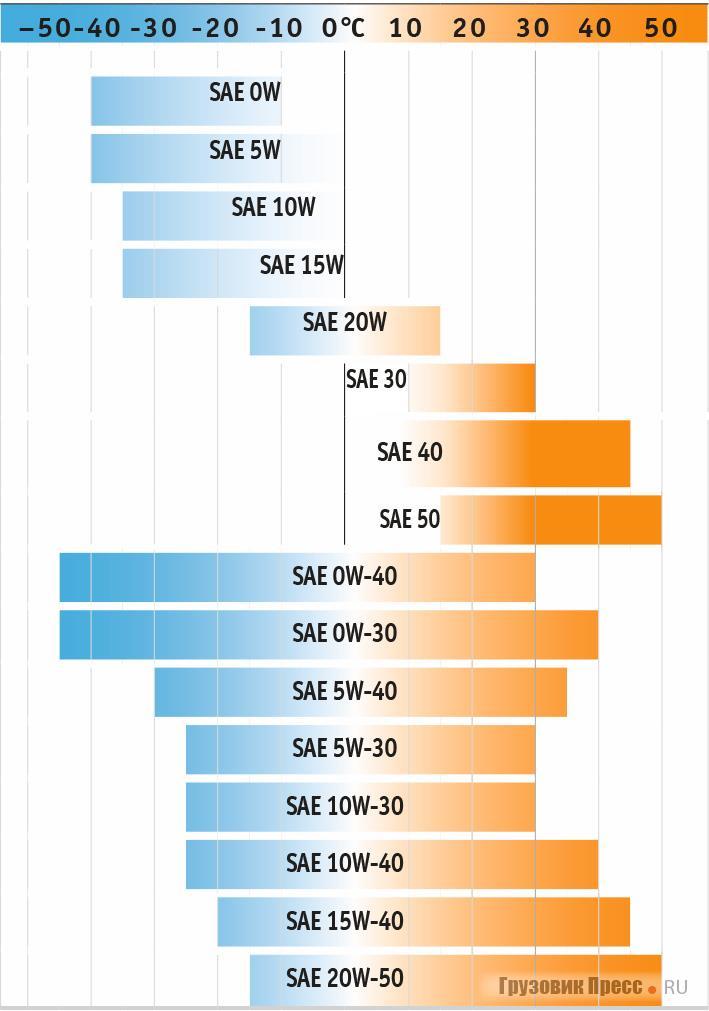
Engine oil marking according to SAE, API, ACEA
SAE viscosity
The viscosity index is the most recognizable designation. Today, more than 90% of motor oils are labeled according to SAE J300 (a classification created by the automotive engineering community). According to this classification, all engine oils are tested and labeled in terms of viscosity and depending on the temperature of the transition to a non-operating state.
The SAE designation consists of two indices: summer and winter. These indices can be used both separately (for specific summer or winter lubricants) and together (for all-season lubricants). For all-season oils, the summer and winter indices are separated by a hyphen. Winter is written first and consists of a single or double digit number and the letter "W" after the numbers. The summer part of the marking is indicated through a hyphen with a number without a letter postscript.
According to the SAE J300 standard, summer designations can be: 2, 5, 7,5, 10, 20, 30, 40, 50 and 60. There are fewer winter designations: 0W, 2,5W, 5W, 7,5W, 10W, 15W , 20W, 25W.


The SAE viscosity value is complex. Namely, it indicates several characteristics of the oil. For the winter designation, it takes into account such parameters as: the pour point, the temperature of free pumpability by the oil pump and the temperature at which the crankshaft is guaranteed to turn without damaging the necks and liners. For example, for 5W-40 oil, the minimum operating temperature is -35°C.
The so-called summer index in the SAE marking shows what viscosity the oil will have at a temperature of 100 ° C (in the engine operating mode). For example, for the same SAE 5W-40 oil, the kinematic viscosity is from 12,5 to 16,3 cSt. This parameter is the most important, since it determines how the oil film behaves in friction spots. Based on the design features of the motor (clearances in mating surfaces, contact loads, speed of mutual movement of parts, roughness, etc.), the automaker selects the optimal viscosity for a particular internal combustion engine. This viscosity is indicated in the operating instructions for the car.
Motorists erroneously link the so-called summer index directly with the permissible oil operating temperature in summer. There is such a connection, but it is very conditional. Directly, the summer index indicates only one value: the viscosity of the oil at 100 ° C.


Watch this video on YouTube
API classification
The second most common designation is the API oil classification (American Petroleum Institute). Here, too, a set of indicators is included in the marking. We can say that this classifier indicates the manufacturability of the oil.
The decoding proposed by the engineers of the American Petroleum Institute is quite simple. The API classification includes two main letters and, in some cases, a hyphenated number that specifies the area of \uXNUMXb\uXNUMXbuse of a particular oil. The first is a letter indicating the area of applicability of the oil, depending on the engine power system. The letter "S" indicates that the oil is intended for gasoline engines. The letter "C" indicates the diesel affiliation of the lubricant.


The second letter refers to the manufacturability of the oil. Manufacturability means a large set of characteristics, which has its own set of requirements for each individual API class. And the further from the beginning of the alphabet the second letter in the API designation, the more technologically advanced the oil. For example, API grade SM oil is better than SL. For diesel engines with particulate filters or increased loads, additional marking letters can be used, for example, CJ-4.
Today, for civilian passenger cars, the SN and CF classes according to API are advanced.


ACEA classification
The European Automobile Manufacturers Association has introduced its own system for evaluating the applicability of motor oils in certain engines. This classification consists of a letter of the Latin alphabet and a number. There are four letters in this technique:
- A - gasoline engines.
- B - diesel passenger cars without particulate filters.
- C - vehicles with a diesel engine equipped with a particulate filter.
- E - commercial vehicles with heavily loaded diesel engines.
The number after the letter indicates the non-manufacturability of the oil. Today, most motor oils for civil vehicles are universal and are labeled as A3 / B3 or A3 / B4 by ACEA.


Other Important Features
The properties and scope of engine oil are also affected by the following characteristics.
- Viscosity index. Shows how much the oil changes viscosity as the temperature rises or falls. The higher the viscosity index, the less dependent the lubricant is on temperature changes. Today, this figure ranges from 150 to 230 units. Oils with a high viscosity index are better suited for climates with a large difference between the maximum and minimum temperatures.
- Freezing temperature. The point at which the oil loses fluidity. Today, high-quality synthetics can remain fluid at temperatures as low as -50°C.
- Flash point. The higher this indicator, the better the oil resists burnout in the cylinders and oxidation. For modern lubricants, the flash point averages between 220 and 240 degrees.


- sulfate ash. Shows how much solid ash remains in the cylinders after the oil burns out. It is calculated as a percentage of the mass of the lubricant. Now this figure ranges from 0,5 to 3%.
- Alkaline number. Determines the ability of the oil to clean the engine from sludge deposits and resist their formation. The higher the base number, the better the oil fights soot and sludge deposits. This parameter can be in the range from 5 to 12 mgKOH/g.
There are several other characteristics of engine oil. However, they are usually not indicated on canisters even with a description of the detailed characteristics on the label and do not have a big impact on the performance properties of the lubricant.


Watch this video on YouTube

